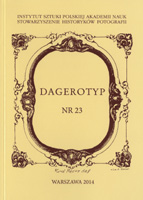Nokturny Antoniego Anatola Węcławskiego (1891-1985)
Nocturnes of Antoni Anatol Węcławski (1891-1985)
Author(s): Magdalena Durda-DmitrukSubject(s): Fine Arts / Performing Arts, Photography
Published by: Instytut Sztuki Polskiej Akademii Nauk
Keywords: photography; nocturn; Polish photography; vintage photography; history of photography; old photographic technique; Warsaw; Polish Photo Club; nocturnal landscape; Węcławski; Antoni Anatol; pictorial photography; urban landscapes
Summary/Abstract: The purpose of this article is to commemorate the little known and almost forgotten after the Second World War, yet an outstanding Polish photographer, Antoni Anatol Węcławski (1891-1985), and to reflect on his abundant output motif – the nocturnes. Węcławski was born into an outclassed gentry from Kresy. His first photography course took place in 1925 at Warsaw Photography Lovers Centre and it comprised beginner and principled photography techniques. In order to become a professional photographer he ran, for several months in 1926, his own seasonal photo workshop in Druskieniki. During the following years he performed artistic photography and he eagerly joined both Polish and foreign exhibitions. Between the years 1929-1933 and 1935-1937 Węcławski took part in several collective exhibitions. In the international and domestic competitions he became a laureate of numerous awards and nominations. With a portfolio full of successes that promoted Polish photography he was recognized and invited to join Polish Photo Club, an association of the most prominent artists. Irrespective of his artistic activities he regularly wrote reviews for photography magazines, that also published his awarded photographs. What’s more Węcławski conducted lectures and readings on photography. In the years 1946-1961 Węcławski taught photography techniques and theory. He died at the age of 94 in Warsaw. An abundant and diversified collection of the photographer has been preserved and kept by his daughter, Hanna Węcławska, in their family house in Gołąbki: vintage prints, negatives, cameras and other utensils, there is also evidence for Węcławski’s other artistic, didactic or social activities. This indicates not only his flamboyant life, output, interests, and aspirations, but also the society which he cofounded. Yet another profile of Węcławski is revealed thanks to those preservations. He was an outstanding pictorialist, an aesthete, a bromine technique virtuoso, an enthusiast of principled photo techniques, a collector of sublime photographic equipment, a charismatic educationist, a megalomaniac, and an individual. In addition, he was an artist who had a wide repertoire of swiftly commanded motifs like: portraits, acts, still life, genre art - folk, ethnographic, marine, and urban landscapes with predominant views of the Warsaw Old Town. Węcławski is yet mostly recognized as a specialist in poetic, melancholic, and understated nocturnes which he created during his most fruitful period of life 1926-1935. The most recognizable themes include architecture, urban landscapes with staffage, genre scenes from night walks and games, picturesque shots of Vistula river and lit bridges, weather conditions, and interior scenes kept in a stimmung mood. Undoubtedly, those lyrical, graceful, and tasteful compositions, sometimes close to abstracts, prove that the author was truly a virtuoso of that genre.
Journal: Dagerotyp
- Issue Year: 2014
- Issue No: 23
- Page Range: 31-54
- Page Count: 24
- Language: Polish
- Content File-PDF

